
It's about how to be a professional English reader.
- Subject:
- Languages
- Material Type:
- Student Guide
- Author:
- Samih Alkhouly
- Date Added:
- 04/25/2023

It's about how to be a professional English reader.
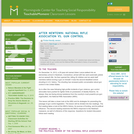
In the wake of the tragic school shooting in Newtown, CT, students learn about and discuss renewed calls for gun control and the National Rifle Association's history of successfully resisting such reforms.

Students use Library of Congress primary sources to examine 19th and 20th century social life in the United States in order to formulate ideas about the American Dream.
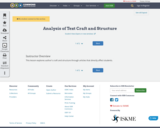
This lesson explores author's craft and structure through articles that directly affect students.
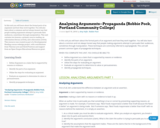
In this unit you will learn about the formal parts of an argument and how they work together. You will also learn about a common and not always honest way that people making arguments attempt to persuade their audiences, sometimes through manipulation.
This unit contains two lessons, a primary source reading, an information literacy activity, and a discussion activity.
This resource was created as part of a Developmental Reading course redesign project, with contributions from Theresa Love and David Pontious and support from an Open Oregon Educational Resources grant.

This resource is designed to walk students through the process of completing a research project in any field of study. It covers the earliest stages of brainstorming and discussing, continues through researching and compiling sources; writing, documenting, revising, and polishing a paper; and finally presenting the research topic to a wider audience in a professional manner. The focus is on MLA format, though the course could be modified for other formats.
The first unit is an introduction to the project. It asks students to draw on knowledge of issues affecting their own community and world to help generate discussion that could eventually lead to a research topic.
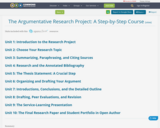
This resource is designed to walk students through the process of completing a research project in any field of study. It covers the earliest stages of brainstorming and discussing, continues through researching and compiling sources; writing, documenting, revising, and polishing a paper; and finally presenting the research topic to a wider audience in a professional manner. The focus is on MLA format, though the course could be modified for other formats.
The first unit is an introduction to the project. It asks students to draw on knowledge of issues affecting their own community and world to help generate discussion that could eventually lead to a research topic.
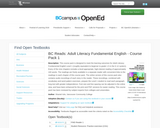
Description: This course pack is designed to meet the learning outcomes for Adult Literacy Fundamental English Level 1 (roughly equivalent to beginner to grade 1.5 in the K-12 system). Every of the nine chapters includes a level-appropriate, high-interest reading of approximately 100 words. The readings are freely available in a separate reader with convenient links to the readings in each chapter of this course pack. The online version of this course pack also contains audio recordings of each story in the reader. These recordings, combined with vocabulary and word pattern exercises, prepare the Level 1 student to read each paragraph-long text with greater independence. Font size and line spacing can be adjusted in the online view, and have been enhanced for the print and PDF versions for easier reading. This course pack has been reviewed by subject experts from colleges and universities.

Students will examine how patriotism comes in many forms through an analysis of the short film "Patriotism and Protest." In the film, experts and Minidoka survivors highlight how the infamous "loyalty questionnaire" during WWII divided the Japanese American community.

Students will examine how news outlets and government propaganda shaped war hysteria and racism against Japanese Americans during WWII. In the short film, "Power of the Press," students will learn about the pre-war racism against Asian Americans and how community allyship can have a profound effect in combating propaganda.

Students will examine how language shapes public perception through an analysis of the short film "Power of Words." In the film, experts highlight the various euphemisms used by the US government to describe the WWII incarceration of Japanese Americans and how the language used to describe this event did not match the reality.

Students will examine the responsibility of citizens through an analysis of the short film "Standing Up for Others." In the film, Japanese Americans draw parallels between their experience during World War II and the experiences of Muslim Americans and asylum-seeking migrant children.
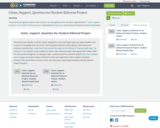
These discussion guides may be used as part of an anticipatory set to introduce argumentation. "Claim, Support, Question," is a "Visible Thinking Routine" developed by Project Zero at the Harvard Graduate School of Education.
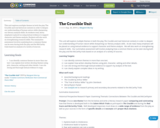
This unit explores multiple themes in both the play The Crucible and real historical contexts in order to deepen our understanding of human nature while sharpening our literary analysis skills. As students read, heavy emphasis is placed on using textual evidence to support character and theme analysis. Students will also work on strengthening research skills. The summative assessment involves analyzing how a common theme can be seen during both the play and the McCarthy trials based on analysis of a variety of sources.
The information revolution of the 21st century is as significant and transformative as the industrial revolution of the 19th century. In this unit, students – and by proxy their families – will learn about the challenges of our current information landscape and how to navigate them. This unit is split into four modules. These modules can be done sequentially or stand on their own, depending on students’ needs and teachers’ timeframes. In this module (1 of 4), students analyze their own use of online social media platforms and learn how filter bubbles and confirmation bias shape the content of their media environment.


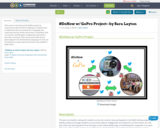
This resource introduces the DoNow project in conjunction with the GoPro challenge. It explains how to implement this curriculum into a language arts classroom (virtual, bricks and mortar, or blended), with an overview, detailed plan, assignments and rubrics, and other resources.
This resource provides lesson plans aligned to CC Standards for language arts that can be adapted to a wide range of LA levels, from middle to high school.

The 11th grade learning experience consists of 7 mostly month-long units aligned to the Common Core State Standards, with available course material for teachers and students easily accessible online. Over the course of the year there is a steady progression in text complexity levels, sophistication of writing tasks, speaking and listening activities, and increased opportunities for independent and collaborative work. Rubrics and student models accompany many writing assignments.Throughout the 11th grade year, in addition to the Common Read texts that the whole class reads together, students each select an Independent Reading book and engage with peers in group Book Talks. Students move from learning the class rituals and routines and genre features of argument writing in Unit 11.1 to learning about narrative and informational genres in Unit 11.2: The American Short Story. Teacher resources provide additional materials to support each unit.